Oswego West Pierhead Lighthouse
Oswego, New York - 1934 (1822**)
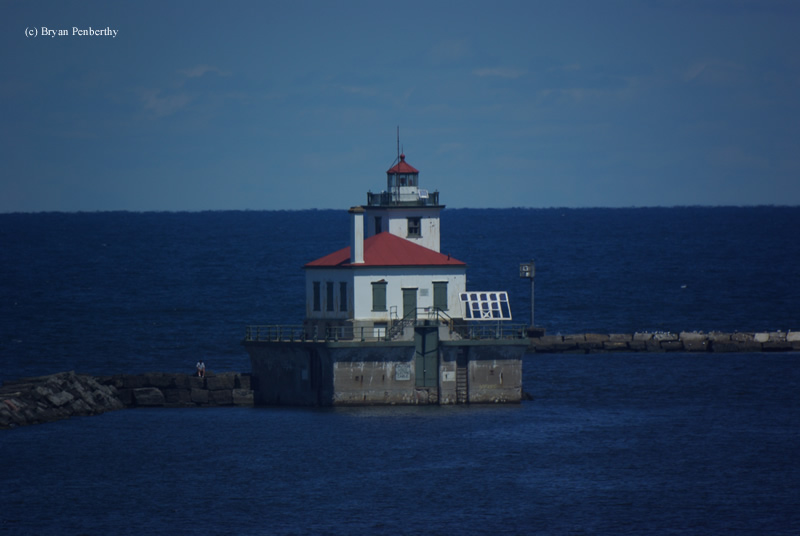
History of the Oswego West Pierhead Lighthouse
Posted/Updated by Bryan Penberthy on 2014-11-23.
Long before the Oswego West Pierhead Lighthouse was established, the British had set up a trading post in the area as early as 1722. To protect the post, it was enclosed by a log palisade, which was later called Fort Oswego.
Where the Oswego River empties into Lake Ontario, a natural harbor is formed. The government recognized this, and on March 3, 1821 authorized the construction of a lighthouse on the eastern shore of the Oswego River, just below Fort Ontario.
The act of March 3, 1821 provided "That the Secretary of the Treasury be authorized and empowered to provide, by contract, for building a light-house at the mouth of Oswego River, at such place as shall be designated by the Secretary of the Treasury, in the State of New York."
In planning for construction of the lighthouse, on July 13, 1821, the New York State Legislature ceded six acres of land at the mouth of the Oswego River, just below the northwest section of Fort Ontario. Daniel Warren and William Cobb of Rochester were selected as the contractors on August 6 to construct the lighthouse, dwelling, and well at a cost of $2,600.
The octagonal lighthouse, constructed of stone, had a base diameter of 14 feet and narrowed to 7.5 feet at the floor of the lantern. Per the contract, the lantern was to be of iron, octagonal in shape, 4'6" in diameter and 4'10" tall. The top of the lantern was a dome, some 2'4" high, and covered in copper. Inside the tower, wooden steps led to the lantern.
The keeper's dwelling was to be constructed of stone, 34' by 20', and divided into two rooms, with an entry between them. Stairs in the entry would lead to the chambers above. Each room was to have a fireplace for warmth and a cellar sat below the entire structure.
The lighthouse and keeper's cottage were completed April 10, 1822 and Oslo Steele was hired as the first keeper. Three years afterward, the Erie Canal was completed, linking Buffalo to New York City. Several years after that, a canal would tie the Erie Canal and Lake Ontario together.
Building of the Oswego Canal started in 1828 near the Syracuse suburb of Clay. While traversing the nearly 24-mile long canal, vessels must pass through 7 locks to accommodate the 118' change in elevation. When the canal was completed in 1829, it created the only Atlantic Ocean / Hudson River connection to Lake Ontario.
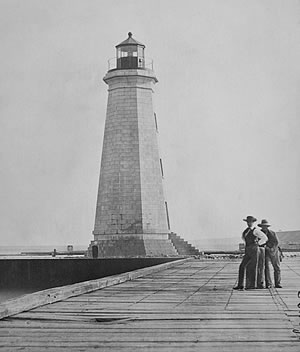 1837 Oswego Lighthouse
1837 Oswego Lighthouse
This connection helped bring an influx of vessels into the Port of Oswego. Like most early lighthouses, construction quality was poor, and by the mid-1830s, the Oswego's lighthouse was in dilapidated condition. In 1837, a new octagonal limestone lighthouse was constructed at the end of a pier on the west side of the Oswego River.
Two years later, Lieutenant Charles T. Platt, U.S. Navy, inspected most of the lighthouses of the tenth district, which led from the St. Lawrence River, down into Ohio. His report spoke highly of the newly constructed lighthouse and the "splendid harbor:"
Oswego light-house, or beacon, is lighted with thirteen lamps, with the same number of bright reflectors, and located on the west pier, at the entrance of the harbor. This is a first-rate building, and is kept in excellent order. The supplies furnished by the contractor are without fault. The public improvements in the rebuilding of the piers are in rapid progress, and, when finished, will remain for at least a century. This is a splendid harbor, extending about half a mile in the river, with sufficient depth of water for the largest class of vessels; its breadth is about 2,400 feet.
The commercial importance attached to this harbor is such as places it beyond competition on this lake.
The old light-house is in a dilapidated state; the fixtures, however, are taken care of, and are in the possession of the keeper. The dwelling wants trifling repair; all of which may be done for fifty dollars.
The old lighthouse was sold on August 4, 1841 and was most likely dismantled the following year. The twin villages of Oswego and East Oswego were united when the city was incorporated in 1848. By 1854, the lighthouse and its pier required some repairs, and $5,000 was appropriated for the work.
The work never completed and by 1859, additional work on the pier was needed. A special act of Congress dated March 3, 1859 provided two separate appropriations:
For repairing and securing the pier connected with the light-house at Oswego, New York, so as to prevent the destruction of said light-house, ten thousand dollars.
For repairs and incidental expenses to the light-house at Oswego, and the buildings connected therewith, thirty thousand dollars.
By the following year, the report stated that the lighthouse pier was repaired, however, not enough to "place the works of that harbor in perfect order," but enough was done to save the "expensive and valuable work from the storms of the coming fall and winter."
Throughout the 1860s, several companies extended rail lines to Oswego, including the New York, Ontario and Western Railway, the Delaware, Lackawanna and Western Railroad, and the New York Central Railroad transforming Oswego a major rail hub. With the increase of shipping traffic in the harbor, and several rail lines, Oswego quickly became recognized as the "Port City of Central New York."
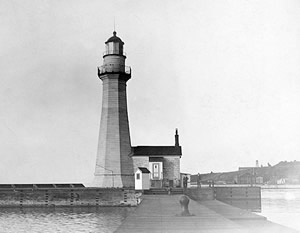 Oswego Lighthouse after 14 foot addition
Oswego Lighthouse after 14 foot addition
Plans to upgrade the Oswego Lighthouse started coming together in 1867. Work included raising the tower, a new lantern, and changing out the fourth-order Fresnel lens for a larger third-order. Progress was made on the lantern and deck plate the following year, however, the stone to raise the tower could not be obtained before the close of the navigation season.
It was likewise reported that the keeper's dwelling required considerable work, the cistern and fences needed minor repairs, and the well had partially caved in, rendering it useless. A new boat was also requested.
That work was carried out in 1869. The Report of the Secretary of the Treasury on the State of the Finances for the year 1869 had the following entry summarizing the effort:
Oswego - The work of raising the tower fourteen feet, putting on a new lantern, building an inner brick wall and watch-room for the keeper, is nearly completed, when a third-order revolving light will be substituted for the present fourth-order fixed light. The dwelling is being reshingled, plastered, and painted, and the well and drain are undergoing repair. Davits will be erected on the pier for the safe-keeping of the boat. When these works are completed the premises will be in good condition.
Oswego Pierhead Lighthouse
Started in 1868, the pier on which the lighthouse sat, was extended some 500 feet into Lake Ontario, which was finished in 1870. Prior to that, most of the harbor developments were at or near the mouth of the Oswego River.
To mark the end of the recently lengthened west pier, a small glazed box fitted to the top of a mast, was framed into the pier. As the west pier was exposed to the force of the lake, at times, it was impossible for the keeper to safely reach the pierhead.
To insure that the keeper could safely service the light, two 3/8-inch galvanized wire ropes were strung from the second story of the stone lighthouse to iron bars on the top of the mast. This system supported a lantern six inches in diameter displaying a fixed white light that was run upon them from the tower to the mast.
By 1872, the Oswego Pierhead Light was upgraded to a small frame beacon with a focal plane 23 feet above the level of the lake. To ensure the keeper's safety, a strong elevated wall was built on it. However, the design of the light included sash-bars which were nearly 10-inches wide which practically obscured the light.
The change would have involved replacing the wooden bars with iron and some modification to the lantern and glass, however, no changes were likely made. An entry in the Annual Report of the Lighthouse Board for the year 1877 detailed that material for an iron beacon has been acquired. The entry is listed here:
523. Oswego Pier-head, entrance to Oswego Harbor, New York - Material for a new iron beacon has been prepared to replace the old wooden one at this station, which was in need of extensive repairs. It will be erected during the present season. The cost of the work will be paid from the general appropriation.
The new iron pierhead beacon was constructed in 1878 on an independent crib. After which, the old wooden tower was torn down. The new iron tower stood 35 feet tall and was equipped with a sixth-order Fresnel lens.
As commerce continued to grow at the Port of Oswego, the River and Harbor Act of July 11, 1870 called for the construction of an outer harbor by building an outer breakwater some 5,800 feet long, parallel to the old west breakwater.
By 1879, the breakwater was moving along at a rapid pace and was expected to be an "obstruction that should be marked." As both the Oswego Main Light and the Pierhead Beacon were a considerable distance from the new outer breakwater, they would be of little use to help mark it.
Makeshift plans were made to adapt the Pierhead Beacon for the time being, but the Lighthouse Board made a recommendation for a permanent structure. Their plans are detailed below:
For the present, the position of the end of the breakwater may be marked by screening the red beacon-light from it, vessels not to stand in for the mouth of the harbor until they make the red light. But eventually a strong light with a fog-bell should be placed on an independent crib just inside the end of the finished work, as is done at the channel end of the Buffalo breakwater, the structure having accommodations for two keepers at night, as it will be difficult of access in stormy weather. An appropriation of $20,000 should be made for this purpose, as it is estimated the work will cost that amount.
In 1880, the boathouse for the Oswego Lighthouse was rebuilt, the tower was repointed and dwelling was repaired. That same year, repairs were made to the elevated catwalk for the Oswego Pierhead Beacon, and inside the tower, shelving for oil and other conveniences were installed.
Oswego Breakwater Lighthouse
It was noted in the 1880 report that once the new breakwater was completed, the pierhead lighthouse would be unnecessary, and could be replaced by a much smaller stake light, allowing the iron lighthouse to be used elsewhere.
The following year, the lighting apparatus of the Oswego Light was changed over to mineral oil. For the Pierhead Beacon, plans were submitted for a new foundation just inside the east end of the new breakwater. By 1882, a mast light was erected in place of the pierhead beacon. Mast lights were also installed at either end of the new east jetty.
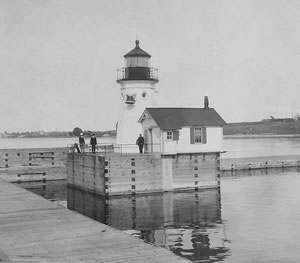 Oswego Breakwater Lighthouse circa 1903
Oswego Breakwater Lighthouse circa 1903
Bids went out for construction of the crib and concrete foundation in 1881, however, all bids received were deemed unreasonable. As the establishment of a light on the crib was a case of public exigency, authority was granted to build the crib and foundation with day's labor, and purchase the necessary materials on the open market.
A 35 foot square crib was constructed just inside the east end of the west breakwater. Once the crib was completed, the iron Oswego Pierhead Beacon was transferred to it on October 17, 1881. Built within the crib was a 5-foot by 8-foot oil and storage room, covered over with an arched tin roof to safely store the volatile kerosene.
Various modifications were made to the tower to prepare it for its new duty in 1882. Inside the tower, a locker, cupboard, and bunk were built to accommodate a keeper. Should fog roll in off the lake, a fog bell was suspended from the north side of the tower, struck at 10-second intervals. The last change made was to increase the order of the light from sixth to fourth-order, visible for 360°.
The following year, a 26-foot by 10-foot boathouse was erected on the south side of the crib, with the boat-launching apparatus placed under it.
Oswego West Pier Problems
In 1885, the War Department transferred a portion of the old west breakwater to the Lighthouse Board, however, nearly 146-lineal-feet were decayed and required replacing. During a gale on October 29, 1887, the east face of the pier was damaged, washing away several decayed sections of timber.
In 1888, as efforts to get the work completed under contract failed, materials were purchased on the open market and the work carried out by day laborers. While rebuilding the crib, a 12 foot by 16 foot space was left under the oil and watch room of the Oswego Lighthouse. The stone walls were plastered with cement, shelves installed for storing oil cans, and stone steps were built leading from the basement up to the watch room.
Other repairs were carried at that time, including a new storm-house built over the front entrance of the watch room, exterior stone work was repointed, the keeper's dwelling was re-shingled, and 24-feet of plank walk were laid.
Problems continued to plague the pier. In 1888, a fire damaged a section of the west pier. Later that year, a gale struck on August 13 damaging the superstructure of the channel face. Bids to repair the structure were requested, however, upon opening them on June 14, 1889, they were all rejected as it was less expensive to purchase the material in the open market, and have the work completed by hired labor.
The extensive work on the pier was detailed in depth in the Annual Report of the Lighthouse Board for 1890. Several other minor repairs to the Oswego Lighthouse and keeper's dwelling were noted as well. Repairs to the pier would be needed again in 1895, 1898, 1899, and 1902.
By 1890, the Lighthouse Board started fielding complaints regarding the Oswego Breakwater Lighthouse. Many captains argued that they could not hear the fog bell, even though the keeper could prove that was being rung. They reported that they needed to be within a half-mile of the lighthouse before they could hear it.
The Lighthouse Board admitted to the uncertainty of a bell as a fog signal and made a recommendation that a steam fog signal be substituted in. The board estimated the cost of the signal to be $4,300, and recommended that the appropriation be made.
The same request appeared in the Annual Reports of the Lighthouse Board for 1891 through 1893, but nothing was ever done. A report of 1898 indicated that a fog bell struck by machinery was in use at the Oswego Breakwater light, and another report indicates that it was repaired in 1901, evidence that the steam signal appropriation was never approved.
The keeper's dwelling of the Oswego Lighthouse was rebuilt under contract in 1897 and at that time, it was connected to the public sewer system. To finish off the yard, the lot was graded, new cement walks were laid, and the property was fenced in. Per the contract, the work was to be completed by September 5, 1897.
In 1898, the boathouse for the Oswego Breakwater Light was extended and remodeled to provide improved quarters for the keepers. Two years later, the color of the tower was changed from brown to white, providing a better day mark.
Metal work for an iron oil house for the Oswego Lighthouse was purchased in 1905. At that same time, a concrete foundation for the oil house was constructed. By 1908, a fireproof oil house was requested for the Oswego Breakwater Lighthouse as well.
Oswego Lighthouse Discontinued
A Notice to Mariners put out on April 15, 1917 stated that the 1837 stone Oswego Lighthouse on the west pier was being discontinued as of that date. At that time, the Oswego Breakwater Lighthouse was changed to a fixed white light of 2,900 candlepower, and going forward, would be known as the Oswego Light.
At that time, a new light, known as the Oswego Inner Light, was established "in the vicinity of the old Oswego Light Tower." This light, most likely on a mast, was to be 28 feet above the water, and displayed a fixed red light of 50 candlepower.
As the octagonal stone lighthouse sat unused since 1917 when it was discontinued, the Lighthouse Service was worried that either ice or heavy seas from the northeast would cause the tower to topple down and obstruct the channel. As such, in 1927, they requested proposals for demolition.
Captain Charles H. Tucker, lightkeeper of the Oswego Light, distributed proposals within the city detailing the requirements: "The contractor shall remove the tower and former lightkeeper's dwelling, all of cut limestone, and level both structures to the surface of the pier on which they stand. No materials may be dropped or thrown into the river or harbor adjacent and the post range light on the pier must be maintained."
Additional details stated that the sealed bids were to be opened on August 2, 1927, the work was to be completed within 90 days, and the contractor could keep the materials.
The Army Corps of Engineers recommended in 1930 that the depth of the Oswego Harbor be increased to enable movement of deep draft lake carriers. The alterations to the harbor included construction of a new arrowhead breakwater and dredging the harbor to a depth of 23 feet at low water.
Two contracts were awarded for the work. The first contract was awarded in October of 1930 to A. Phelps and Son of Detriot, Michigan for the construction of the east breakwater. In February of 1931, a contract was awarded to the Great Lakes Dredge and Dock Company for the construction of the west breakwater.
Before the Great Lakes Dredge and Dock Company could start construction of the new west arrowhead breakwater, they had to remove a large portion of the old breakwater, which included a section with the Oswego Lighthouse.
The Lighthouse Service discontinued the Oswego Lighthouse on August 10, 1931 and replaced it with a temporary light on the roof of the barge canal terminal elevator. Once the breakwater was completed, the Great Lakes Dredge and Dock Company built a 50-foot-square timber crib and anchored it to the floor of the lake, which was solid rock. The crib was then filled with stones and topped off with reinforced concrete.
Oswego West Pierhead
The Oswego West Pierhead Lighthouse was designed and fabricated at the Tenth Lighthouse District Depot in Buffalo, New York and then transferred to the crib at Oswego, where it was erected, and was placed into service on November 24, 1934.
Shortly after the lighthouse was placed into service, members of the press at the Oswego Palladium-Times were invited to visit the station. Below is a summary of their description of the lighthouse:
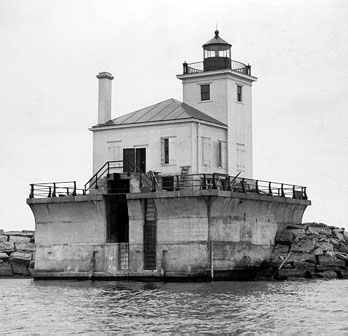 1934 Oswego West Pierhead Light (C.G.)
1934 Oswego West Pierhead Light (C.G.)
The basement, built into the crib, contains an electrically-driven air compressor for the fog signal and a gasoline-powered air compressor as a standby in case of power failure. Other equipment included a steam-heating unit and compact boiler, standby electric generator, electric pump for sanitary system, bank of batteries, and a switchboard.
A set of steel stairs lead to the second floor, which contains a living room, radio room, kitchen, bathroom, and bedrooms. The group went on to tell how the radiobeacon at the Oswego Lighthouse operated at 360 Kilocycles, its characteristic was a dot and two dashes, and could be heard as far away as Buffalo and ports on Lake Ontario.
The fog signal installed at Oswego was known as a tyfon. Its characteristic was silent for 27-seconds, with a three-second blast, each half minute. The tyfon was audible for up to 20 miles, and was synchronized with the radiobeacon for distance finding.
The press continued their tour of the station, and went up another flight of steel steps to the lantern, which they noted was "kept in a state of immaculate cleanliness." The fourth-order Fresnel lens was moved over from the old Oswego Breakwater Light and mounted in the lantern. The occulting light was produced from a single 300-watt bulb, located 57 feet above the water level.
The keepers on duty were not only responsible for the Oswego Lighthouse, but several others in the harbor, including the east breakwater light, gas buoys near the harbor entrance, inside the harbor, and at the Ford Shoals, west of Oswego, and the light on the state terminal elevator, which was established temporarily while the current lighthouse was under construction, and then retained at the request of mariners.
Oswego, New York experienced one of the worst winter storms in early December 1942. Karl A. Jackson was on duty at the lighthouse for most of the week as the seas were too rough to transfer keepers at the end of their 24-hour watch. That Friday, December 4, 1942, the winds had dropped from 65 miles per hour to 30 miles per hour, which led Lieutenant Wilson, Commanding Office of Oswego station, to believe that the transfer could be done safely.
Seven members, including the two relief keepers boarded a picket boat and headed to the lighthouse. After successfully transferring the relief keepers and taking aboard Karl Jackson, a wave smashed their boat against the crib, stoving in several planks and stalling the motor.
While taking on water, the rough seas then pulled the boat out into the harbor, where it eventually smashed against the east breakwater. Upon impact, the eight men were thrown into the water, of which, two were able to make it to the breakwater.
Another motor lifeboat was sent out to help those in distress. To gather the men from the breakwater, a light skiff was launched from the lifeboat. Upon reaching the breakwater, it too was smashed against the rocks from the force of the waves, adding two more that needed rescuing from the wall.
The motor lifeboat then headed out into the open lake to see if there were any survivors clinging to the sinking craft, of which none were found. It then went back into the harbor where it was able to rescue the four personnel from the breakwater.
Six Coast Guard crew members perished that day. The six who perished were: Lieutenant Alton J. Wilson, Karl A. Jackson, Leslie J. Holdsworth, Ralph J. Sprau, Irving Ginsburg, and Eugene C. Sisson.
The Coast Guard automated the lighthouse in 1968 relieving personnel from future transfers. In 1995, the fourth-order Fresnel lens was removed from duty and replaced with a solar-powered light. Today, the lens is at the H. Lee White Maritime Museum in Oswego.
Determined by the Coast Guard to be unnecessary, on June 1, 2006, the Oswego Harbor West Pierhead Lighthouse became available through the National Historic Lighthouse Preservation Act of 2000 at no cost to any eligible public or non-profit entity.
After several years of jumping through hoops, the City of Oswego took ownership of the lighthouse in May of 2009. The Syracuse engineering firm C & S Cos. Examined the structure and found that although it was in good condition, there were several items that needed to be taken care of.
As many windows were broken, birds have taken up residence inside the structure, leaving tons of guano. Asbestos tiles and lead paint were some other hazards found within the structure that needed remediation.
The city received a $225,000 grant from the New York State Canal Corp to pay for the study and other rehabilitation work. However, immediate repairs could run in excess of $500,000 and a full restoration could cost more than $2 million.
Once the structure is safe, the city may run shuttles to the lighthouse and allow visitors to tour the tower. Other considerations could include area colleges, such as SUNY Oswego and SUNY ESF, establishing weather and lake monitoring stations at the lighthouse.
In 2012, the City of Oswego approved a contract with A.C.C. Contracting of Rochester, NY for $73,750 to remediate the interior of the station, which included lead paint, asbestos, PCBs, and bird droppings.
Eventually, Ted Panayotoff, chair of the Oswego Lighthouse Development Committee, would like to gather volunteers to for painting and other work on the lighthouse.
Reference:
- Annual Report of the Light House Board, U.S. Lighthouse Service, Various years.
- Various Government Documents, Federal & State Governments, Various dates.
- "Work beginning this week on rehab of Oswego lighthouse," Debra J. Groom, The Post-Standard, September 26, 2012.
- "Lost Lights of Oswego," Timothy Harrison, Lighthouse Digest, May 2000.
- "Oswego gets title to harbor lighthouse," John Doherty, Syracuse.com, May 11, 2009.
- "Work on Oswego Lighthouse to begin soon," Debra J. Groom, The Post-Standard, August 6, 2012.
- "Remembering the Oswego Six," Bill Edwards, Lighthouse Digest, June 2005.
- "Six Coastguardsmen Perish as Launch Sinks in Harbor," Staff, Oswego Palladium-Times, December 4, 1942.
- "Guide to ships, familiar object to Oswegonians," Staff, Oswego Palladium-Times, September 8, 1938.
- Old Shipping Days in Oswego, J. Leo Finn, 1972.
- "Old Lighthouse, Long Landmark, To Be Wrecked," Staff, Oswego Palladium-Times, July 29, 1927.
Directions: From Route 104 in the City of Oswego, take West 4th Street north towards the lake. At the end of this road is the city marina. From here, you can use a 500mm telephoto lens to get a great photo of the lighthouse. One of the best viewing points for this lighthouse is at the end of the pier at the city's marina. I stopped at the gate house and asked the lady if I could go to the end of the pier for a picture. I used a 500mm telephoto lens to get the picture above.
Access: The lighthouse is owned by the City of Oswego. Tower closed.
View more Oswego West Pierhead Lighthouse picturesTower Height: 57.00'
Focal Plane: 57'
Active Aid to Navigation: Yes
*Latitude: 43.47300 N
*Longitude: -76.51700 W
See this lighthouse on Google Maps.
